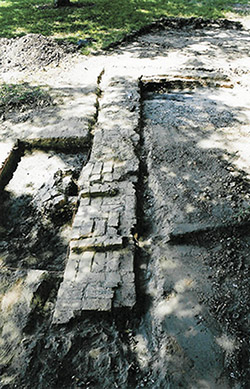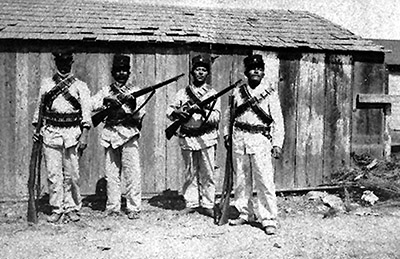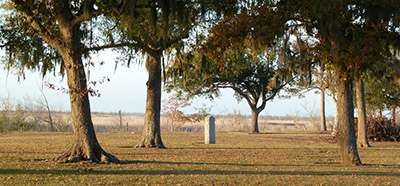 |
Fort Anahuac
Anahuac, Texas, USA
|
|
 |
Constructed: 1831 - 1832
Used by: Mexico,
Texas Militia
Conflict in which it participated:
Texas Revolution
|
The state of Texas is a giant in just about every sense of the word. Historically Texas has always loomed large amongst the United States, preeminent except in one crucial field: When it comes to starforts, Texas is dwarfed by Rhode Island.
This does not mean, however, that Texas was completely bereft of the starfort art. Fortunately for those of us who are interested in such things (and you wouldn't be here if you weren't), Texas' road to independence from Mexico was not a smooth one. |
 |
|
|
Spanish explorer Álvar Núñez Cabeza de Vaca (c 1488-c 1560) and his men were the first Europeans to trod upon what would become Texas, in 1528. Cabeza de Vaca later reported that "half the natives died from a disease of the bowels and blamed us," which is of course ridiculous, as there are no such things as bacteria.
The young United States insisted that Texas was part of the Louisiana Purchase of 1803, which it was not, and local Anglo settlers continued to insist on doing the thing for which they were known (settling) in Texas, despite it clearly being the dominion of the Spanish Empire, and then of Mexico after 1821.
|
|
 |
By the dawn of the 1830's, Anglos outnumbered Mexicans in Texas by a hefty margin. Mexican authorities passed the Law of April 6, 1830 (on April 6, 1830), which aimed to halt the onslaught of greedy Anglo immigrants into Texas. Tasked with enforcing this law was Juan Davis Bradburn (1787-1842).
Bradburn was born in Virginia, but fought for Mexican independence in 1812 and 1813. During the War of 1812 (1812-1815), Bradburn narrowly missed participating in the Battle of New Orleans (January 8-18, 1815) as a volunteer in the Eighteenth Louisiana Regiment, when his unit arrived on the scene just days after the battle. Once released from his unit, he returned to Mexico and continued the fight for independence from Spain. |
|
Part of the Law of April 6, 1830 was the development of customs houses at strategic points of entry to Texas, to enforce customs duties that had been lax up to that time. Fort Anahuac was one of six such custom house/forts built in the region at the beginning of the 1830's. Built with convict labor at the mouth of the Trinity River, near the northern extent of Galveston Bay, Fort Anahuac was essentially a 30' by 40' adobe rectangle, with bastion-like expanses at its eastern and western corners. While certainly shrimpy by proper starfort standards ( Fort Adams in otherwise minuscule Rhode Island again comes to mind, as it was under construction at the same time as was Fort Anahuac), a small fort with thin adobe walls makes sense in Texas in 1831. Unlikely to be called upon to withstand an attack by a powerful European navy and equally unlikely to have any sort of artillery borne against it, adobe was the material at hand, and had been used with reasonable success in dry climates for thousands of years. Fort Anahuac was initially garrisoned with 45 men. |
Unsurprisingly, the local settlers were not pleased with the new enforcement of customs duties. Nor were they delighted by Bradburn's opposition to the granting of official land titles to those settlers living near Anahuac, plus the garrison of Fort Anahuac were convicts themselves, forced to serve in their capacity as soldiers, and difficult for Bradburn to control.
On one occasion two of Bradburn's soldiers assaulted a woman settler, which caused the locals to organize a militia, notionally to defend against Comanche Indian attacks, but clearly to threaten little Fort Anahuac. Bradburn arrested the militia's leader, only to release him when Bradburn received death threats. Way to stick to your guns there, Mr. Authority Figure.
Also involved in what would become known as the Anuahac Disturbances was Texas superstar William B. Travis (1809-1836). Travis was a lawyer with an office in Anahuac, and helped to organize the Texian militia that opposed Bradburn and his force of semidrunken malcontents. Bradburn also arrested Travis, at one point holding him tied to the ground in Fort Anahuac with guns pointed at him, threatening to execute him if the Texians attacked the fort. Travis escaped this dastardly fate, and went on to do the most heroic thing imaginable for a Texan, which was to die while commanding the Texians at the Battle of the Alamo (February 23-March 6, 1836).
|
 |
 Some of the remains of Fort Anahuac today. Adobe bricks: 185 years and still going (relatively) strong! Some of the remains of Fort Anahuac today. Adobe bricks: 185 years and still going (relatively) strong! |
|
By June of 1832, Fort Anahuac's merry garrison had swollen to around 300 men. Violence finally broke out in June of 1832, when the Mexicans fought it out with a number of Texian militia in the town of Anahuac. Despite light casualties on both sides, the Mexicans were nonetheless driven from Fort Anahuac, which was occupied for a month by Texas militia under Frank W. Johnson (1799-1886). The fort was dismantled as the militia left, and many of its adobe bricks were subsequently scavenged by locals for use as building materials.
|
 Mexican troops, benefiting from both rifles and photography that did not exist during the period in which we are currently interested...so they either time-traveled to Fort Anahuac, or these are a bunch of Universal Studios extras posing in Hollywood in the 1930's. Mexican troops, benefiting from both rifles and photography that did not exist during the period in which we are currently interested...so they either time-traveled to Fort Anahuac, or these are a bunch of Universal Studios extras posing in Hollywood in the 1930's. |
 |
As convoluted and weird as this entire episode known as the Anahuac Disturbances was, it was the first armed resistance against Mexican authorities in Texas, and is considered the first fight of the battle for an independent Texas.
Mexico hadn't yet gotten the memo, however, and sent 40 troops under a Captain Antonio Tenorio back to Anahuac in May of 1835 to reestablish the fort. The Mexican government was still interested in collecting customs fees from the local settlers, who still had no interest in complying with such an outlandish request. Tenorio found little left of the original fort, and wood that was sent to rebuild it was immediately burned by the ever-mischievous Texians. |
|
William B. Travis returned to Anahuac at the head of a 25-man militia force, dragging along what was likely to be an extremely small cannon. On June 29, 1835, the garrison of whatever ramshackle collection of burnt timber and small piles of adobe bricks currently representing Fort Anahuac surrendered without a fight. A number of Texians who had been taken prisoner by the Mexicans were released, and Tenorio and his men were permitted to flee the scene. Mexican troops would never again return to Anahuac.
|
The remains of Fort Anahuac rotted until 1946, when Chambers County acquired the property and buried all that dangerous historic rubble. Interest in archaeologically reclaiming the site started in 1968, but serious excavation didn't begin until 2001.
Though the site had been picked over by treasure hunters for decades, several enticing artifacts have been unearthed from the fort's location in recent years.
|
 |
 The towering walls of Fort Anahuac today. Thanks, Fortwiki.com! The towering walls of Fort Anahuac today. Thanks, Fortwiki.com! |
|
Although Fort Anahuac cannot be reconstructed on its original site (as it is protected on the National Register of Historic Places: Protected from reconstructing the thing that was built to protect the site in the first place!), Chambers County hopes to one day erect an interpretive museum at Fort Anahuac Park. Chambers County Historical Commission Chairperson Sheryl Shaw reports that they do intend to purchase two replica six-pounder cannons for the site in the near future, so perhaps all is not lost. Get on that reconstruction, Texas! You need to catch up with Rhode Island!
Many thanks to starfort enthusiast Ben, who unearthed Fort Anahuac for us!
|
|
|
|
|
|
 |




